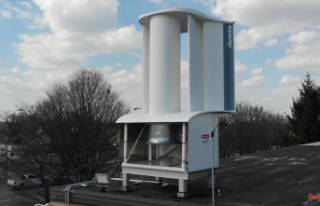A research team from Germany and the USA is causing a stir with a preprint on the suspected artificial origin of the Sars-CoV-2 coronavirus. In their work, they come to the conclusion that the virus very likely originated in a laboratory. One of the researchers is Valentin Bruttel from the University Hospital of Würzburg. In an interview with ntv.de, he explains how he and his co-authors, statistics expert and entrepreneur Alex Washburn and Antonius VanDongen, professor of pharmacology at Duke University in North Carolina, came to their amazing findings - and what he got out of the strong criticism holds, which meets them. Bruttel also reveals why he takes the risk of dealing with an issue that is often labeled as a conspiracy theory.
ntv.de: Mr. Bruttel, you and two colleagues have put a preprint online that has not yet been independently reviewed, which makes a pretty astonishing statement. Accordingly, Sars-CoV-2 very likely comes from a laboratory. How sure are you about it?
Valentin Bruttel: Combined with other molecular clues, our results show that this virus is 99.9 percent an artificial, probably manipulated, copy of a natural virus. Some virology laboratories use very similar methods to produce such highly controversial synthetic viruses as we and many others use to develop protein-based drugs in our case for autoimmune diseases.
How do you come to the conclusion that Sars-CoV-2 was probably artificially manipulated?
RNA viruses such as corona viruses (RNA stands for ribonucleic acid. It carries the genetic information in RNA viruses, editor's note) are very difficult to manipulate genetically. If it is to be targeted, then a method has been established that is based on the fact that the entire viral genome is first analyzed at the DNA level (DNA stands for deoxyribonucleic acid . Red.) compiles. However, even at the DNA level, the approximately 30,000 nucleotides (the basic building blocks of the nucleic acids, i.e. DNA and RNA, editor's note) of such a virus genome cannot simply be produced in one piece. Therefore, a method was developed a good 20 years ago that assembles the entire genome from individual building blocks. The approximately 30,000 nucleotides are broken down into five to eight building blocks that are easy to produce or can easily be ordered today.
However, these building blocks must be reassembled in the correct order in the test vessel afterwards. This is achieved because each building block has a sticky end, a small overhang of one of the two DNA strands, a so-called sticky end, which fits the sticky end of the following building block. In order to produce these sticky ends, so-called restriction enzymes that can cut DNA are used. In order for the building blocks to arrange themselves correctly, it must be ensured that each "glue" between the building blocks only occurs once. Therefore, from the thousands of restriction enzymes, only those are chosen that can produce different sticky ends. Those of type IIS are particularly suitable. With these, the required five to eight building blocks, each with unique sticky ends, can be easily produced with just one enzyme. The most common ones according to the manufacturers, which we also examined, were used, for example, to insert various spike proteins into the WIV1 bat coronavirus in Wuhan.
However, in order for these enzymes to recognize where they need to cut the DNA strand, they need so-called recognition sites, which are usually six nucleotides long, right next to the sticky ends. You can make these recognition sites disappear when you make the virus. However, this was usually not done, which also makes it possible to later exchange individual building blocks in the fully assembled DNA genome. And these recognition sites at a maximum distance of about 8000 nucleotides can also be found later in the RNA genome of artificially produced viruses.
And these detection sites also indicate manipulation with Sars-CoV-2?
Some viruses have already been artificially modified. And you also know the natural model viruses from nature, which were copied. We compared the genomes of known artificially created viruses with those of their natural counterparts. In natural viruses, the recognition sites are completely random, they play no role in the natural evolution of viruses, which never come into contact with these bacterial-derived restriction enzymes. In the artificial viruses, however, there are always only about four to seven of these recognition sites and, above all, they are not too far apart. A production-related pattern is created, a fingerprint. This pattern is also found in Sars-CoV-2, but not in closely related viruses. It is crucial that with Sars-CoV-2 some changes to the predecessor viruses were necessary in order to generate any comparably well-functioning synthetic virus system. Our preliminary results indicate that the probability that natural evolution created this pattern by chance is at most about 1 in 100, probably far less.
Then there are a number of other clues. These recognition sites are always built into artificial viruses by so-called silent mutations. These mutations only change the nucleotide sequences, but not the protein component of the virus that they encode. Even the smallest changes in the proteins could, for example, render them completely unusable and falsify the subsequent experiments. And even with Sars-CoV-2, compared to natural related viruses, only silent mutations are found, which also occur statistically significantly more frequently in precisely these few detection areas.
And the techniques you describe were already widespread before the end of 2019, i.e. before the outbreak of the pandemic?
Yes, as far as I know, the first comparable RNA viruses were produced in this way as early as 2000, in the laboratory of Ralph Baric (a US immunologist and microbiologist known, among other things, for his work with synthetically modified corona viruses, editor's note. ).
How did you come across the peculiarities in the Sars-CoV-2 genome that you described?
Some e-mails were published from which it was clear that virologists also considered an artificial origin to be more likely. I noticed the first anomalies in the genome of Sars-CoV-2 in the summer of 2021 and have since continued to investigate and discuss them in my free time, especially with my co-author Professor Antonius VanDongen. He is particularly familiar with analysis methods for comparing different genomes. I also tried to draw virologists' attention to these patterns, but this did not lead to anything. Then dr. Alex Washburn became aware of our discussion and offered to work out the necessary calculation models and statistical analysis, which is not my area of expertise. We then worked these out into this preliminary publication.
Does your work provide evidence of a laboratory origin of the virus? Or rather a strong indication?
(hesitates) This pattern is comparable to a fingerprint on a murder weapon. We have shown that such a pattern, which is also found in at least ten other synthetic RNA viruses, is extremely unlikely to appear here purely by chance. Our publication focuses only on this fingerprint.
Is that enough to consider a lab accident?
Personally, I think this finding joins a number of other very unambiguous indicators of a laboratory accident that have hardly been reported. There is, for example, the place of origin Wuhan, which is far away from the bat colonies in southern China, where the close relatives of Sars-CoV-2 occur. Also worth mentioning is the furin interface, which appeared for the first time in such a virus, ...
... a spot on the spike protein of the virus that researchers believe gives Sars-CoV-2 a particularly high level of infectivity.
Right. But it's not just any, it's one that is also found in humans, in the protein ENaC-alpha. There are hundreds of other ways to arrive at a functional furin interface.
And there's the fact that the enzymes we've described have been used before to manipulate bat viruses in Shi Zhengli's lab in Wuhan. And then there is the research proposal from 2018 under main applicant Peter Daszak, in which Ralph Baric, Shi Zhengli and a few others jointly planned to incorporate human furin interfaces into Sars-like corona viruses (however, the proposal was rejected, editor’s note. ). Furin cleavage of ENaC-alpha was described at Barics University. The application also described the intention to incorporate human ACE2-binding receptor-binding domains into these southern China bat viruses. Compared to another related virus published from Wuhan, such as RaTG13, the furin cleavage site and the receptor binding motif differ extraordinarily, as if they had been inserted. The pattern we observed would be ideally suited for such changes.
So do you think the virus escaped from a laboratory in the metropolis of Wuhan and triggered the pandemic on the spot?
We try to exclude that in our preprint and only concentrate on this "fingerprint". We also do not make any statement as to which laboratory could be involved, since the information and methods were public. Something like this should be judged by looking at all the facts as a whole, which everyone may weigh differently. My personal assessment of the data situation is that 99.9 percent of the time it must be assumed that it was artificial in origin, most likely an unintentional accident.
Let's assume there was actually a laboratory accident with Sars-CoV-2 in Wuhan. How could this have gone?
According to the Wuhan Institute of Virology, before the start of the pandemic, work on corona viruses was only carried out under low safety conditions, even at biological safety level 2, for which mouth and nose protection is not even mandatory. In my opinion, something like this can happen relatively easily, but you should ask the experts. A researcher may have been bitten by a mouse, something may fall, or aerosols may form. A young employee may have unknowingly been infected, had no symptoms and infected other people. The virus could theoretically have gotten into the city almost everywhere from asymptomatically infected people, and then, according to the gene sequence analyzes of others, first appeared months later at a large superspreader event at the Huanan wet market in Wuhan.
Shortly after it was published, your preliminary publication met with strong opposition from virologists on Twitter. Among other things, it was criticized that the recognition sites could also be hidden if the genome of a virus were artificially manipulated.
That's right. There is the so-called No-See'm technique for this. But this has the disadvantage that once the DNA genome has been assembled, no further changes can be incorporated via these interfaces. In addition, this technique was rarely used before 2019 for similar viruses, the interfaces are usually found in the artificial genome. However, our work is not to be regarded as 100% complete, a pre-release also serves to incorporate suggestions for improvement or corrections. So we now evaluate constructive feedback or criticism from other experts, add to the manuscript, and then everything is examined in detail again in the peer review process by colleagues for a journal. Of course, we also want to know whether we made any technical mistakes or mistakes in reasoning. I'm open to any reasonable criticism.
The well-known researcher Kristian Andersen even called your study "nonsense" on Twitter. She was "so flawed that she wouldn't even pass a molecular biology kindergarten." Only “random noise” can be seen in the Sars-CoV-2 genome. What do you think?
Unfortunately, insults are often used, which I find strange. Mr. Andersen and other virologists have even blocked me on Twitter, so I don't see their comments at first and can't react to them. I've seen some of the arguments, but at first glance there's nothing substantial about them. Another virologist, for example, modeled a predecessor virus on the computer based on Sars-CoV-2, into which many parts and thus also a remote interface were adopted. This first removed BsaI site is still present in all really existing related viruses. His argument now is that, for example, the lack of this interface in Sars-CoV-2 is not exceptional, because it is also missing in the virus copied from Sars-CoV-2 at this point. Incidentally, Professor Andersen himself wrote in internal emails that some properties of Sars-CoV-2 indicate an artificial origin, and then never explained which data made him publish days later that Sars-CoV-2 was absolutely certain of natural origin. Professor Friedemann Weber (Head of the Institute for Virology at the University of Gießen, editor's note) says that such a virus would be assembled without the interfaces being visible later. Our arguments as to why exactly that would not be done if, as planned in Wuhan, one wants to test a large number of receptor-binding domains or furin interfaces, were probably overlooked.
But there was also a lot of positive feedback and constructive criticism, for example Professor Richard Ebright (molecular biology at Rutgers University in the US state of New Jersey, editor's note) considers our preliminary publication to be remarkable and has good points of criticism. Professor Francois Balloux (Director of the Genetics Institute at University College London, editor's note) could not identify any errors and agrees with the core statements. There were already many smaller, very helpful comments and some points simply have to be explained and discussed in much more detail by us, we didn't want to overload the paper. It just takes some time now, but everyone is free to discuss this observation themselves.
Is there a discovery about Sars-CoV-2 that would change your opinion that it was probably created artificially?
Clear. If, for example, a really independent commission travels to China without any conflicts of interest, systematically searches the animal world and finds a predecessor virus from which Sars-CoV-2 could plausibly have originated, the data situation will of course change. Even something like that could also be fictitious. The previous official commission of inquiry into the origin of Sars-CoV-2 by the WHO was not even really allowed into the laboratories and was headed by Peter Daszak, who as the main applicant planned to have furin interfaces used in bat viruses in Wuhan.
In addition, exactly such a possible ancestor of all Sars-CoV-2 lines has already been found. Only the sample did not contain DNA from intermediate hosts, but from laboratory cell lines, which are always used in the production and sometimes in the testing of synthetic viruses. To my knowledge, this was not really discussed in public and is perhaps not known to many virologists.
The idea that Sars-CoV-2 comes from a laboratory is often referred to as a conspiracy theory. As a researcher, don't you take a certain risk if you go public with a preprint like this?
Of course it is a certain personal risk. Professor Roland Wiesendanger, for example, was approached fairly harshly in public for his source study and collection of material. But what would be the risk for all of us simply not to discuss such an observation publicly? Only recently, with the participation of German virologists, a chimeric virus was created in Boston, which probably combines the higher lethality of the original Sars-CoV-2 with better contagiousness and resistance to Omicron vaccines. The fact that permits are required for such experiments was probably ignored, and the funding organization was probably not informed at all about the project. And Sars-CoV-2 is also many times less deadly than most viruses that were artificially produced or manipulated in the laboratory. In Rotterdam, for example, a virus that was almost a hundred times more deadly was modified in the laboratory in such a way that it can probably be transmitted very easily from person to person.
I would like to drop the whole topic immediately and finally do more other things in my free time. But technical progress today enables researchers to produce a virus in a few weeks with a few thousand euros according to public protocols, which could not only completely collapse our medical supply systems. Just as our pre-publication now needs to be discussed in peace, this new danger should urgently be discussed in the general public.
Kai Stoppel spoke to Valentin Bruttel












